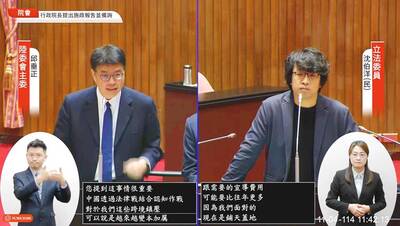Cross-strait relations are “special state-to-state relations” akin to the relations between West and East Germany, former grand justice Hsu Tzong-li (許宗力) yesterday told lawmakers during a review of his nomination to be head of the Judicial Yuan.
Hsu’s comment was in response to Chinese Nationalist Party (KMT) Legislator Alicia Wang’s (王育敏) question on whether his opinions on cross-strait relations were similar to those of former president Lee Teng-hui (李登輝), citing Hsu’s 1996 article, “How Laws Influenced the Changes in Cross-Strait Relations and the Latest Developments” (兩岸關係法律定為百年來的演變與最新發展) in the The Taiwan Law Review (月旦法學雜誌).
Lee’s “special state-to-state” model of cross-strait relations, announced on July 8, 1999, was aimed at countering China’s description of Taiwan as a “renegade province.”

Photo: Chen Chih-chu, Taipei Times
“Taiwan is a distinct sovereign independent nation separate from the People’s Republic of China [PRC] in Mainland China; its name is the Republic of China [ROC],” Hsu wrote in his article, adding: “The ROC is factually and legally independent from all other nations in the world, including the PRC.”
Hsu said he has always claimed “special state-to-state relations” and never used the phrase “two-state theory.”
When asked how his opinion differed from former president Ma Ying-jeou’s (馬英九) “one China, with different interpretations” framework, Hsu said that Ma’s cross-strait model claimed sovereignty over China and outer Mongolia, or the Republic of Mongolia, but that his model did not.
Ma’s preferred model is also known as the so-called “1992 consensus,” a phrase that former Mainland Affairs Council chairman Su Chi (蘇起) admitted to making up in 2000, which refers to a tacit understanding between the KMT and Beijing that both sides acknowledge there is “one China,” with each side having its own interpretation of what “China” means.
“Member of the Legislative Yuan, as well as the president, are elected by the 23 million people in Taiwan since 1991. We do not represent China. Therefore I think our sovereignty does not include mainland China,” Hsu said.
As for the distinction between the “Taiwan Area” and “Mainland Area” as stipulated in the Constitution, Hsu said that this was a political statement written into the Constitution and is not legally binding at the local government level, adding that were it legally binding, it would mean that Taiwanese would have to elect an “area administrator.”
New Power Party (NPP) Executive Director Huang Kuo-chang (黃國昌) asked Hsu about President Tsai Ing-wen’s (蔡英文) executive initiatives.
Huang asked if Tsai’s High-Level Policy Coordination Meeting initiative — a body composed of the premier, Democratic Progressive Party (DPP) secretary-general, key members of the DPP caucus and think tanks — crosses a “red line” regarding constitutional limits on presidential powers.
“I believe it must operate under the constitutional framework and I agree that regulations will cause many difficulties for Tsai. I hope the legislature considers constitutional amendments,” Hsu said.
Huang expressed the concern that the High-Level Policy Coordination Meeting sessions might lead to “controversial constitutional disputes” and asked Hsu if he thought the sessions should proceed as planned.
“I believe it warrants further consideration,” Hsu said.
Presidential Office spokesman Alex Huang (黃重諺) later issued a statement saying that “Hsu was responding to the issue of how the president’s constitutional role and powers should correspond with political responsibility and the spirit of democratic politics, and he believes that certain constitutional requirements require further review and consideration.”
The spokesman dismissed claims that the High-Level Policy Coordination Meeting was an unconstitutional expansion of presidential powers, saying that the sessions would enhance the Cabinet’s policymaking and “should cause no concern with regard to the constitutional boundaries of the president.”

CALL FOR SUPPORT: President William Lai called on lawmakers across party lines to ensure the livelihood of Taiwanese and that national security is protected President William Lai (賴清德) yesterday called for bipartisan support for Taiwan’s investment in self-defense capabilities at the christening and launch of two coast guard vessels at CSBC Corp, Taiwan’s (台灣國際造船) shipyard in Kaohsiung. The Taipei (台北) is the fourth and final ship of the Chiayi-class offshore patrol vessels, and the Siraya (西拉雅) is the Coast Guard Administration’s (CGA) first-ever ocean patrol vessel, the government said. The Taipei is the fourth and final ship of the Chiayi-class offshore patrol vessels with a displacement of about 4,000 tonnes, Lai said. This ship class was ordered as a result of former president Tsai Ing-wen’s (蔡英文) 2018

‘SECRETS’: While saying China would not attack during his presidency, Donald Trump declined to say how Washington would respond if Beijing were to take military action US President Donald Trump said that China would not take military action against Taiwan while he is president, as the Chinese leaders “know the consequences.” Trump made the statement during an interview on CBS’ 60 Minutes program that aired on Sunday, a few days after his meeting with Chinese President Xi Jinping (習近平) in South Korea. “He [Xi] has openly said, and his people have openly said at meetings, ‘we would never do anything while President Trump is president,’ because they know the consequences,” Trump said in the interview. However, he repeatedly declined to say exactly how Washington would respond in

WARFARE: All sectors of society should recognize, unite, and collectively resist and condemn Beijing’s cross-border suppression, MAC Minister Chiu Chui-cheng said The number of Taiwanese detained because of legal affairs by Chinese authorities has tripled this year, as Beijing intensified its intimidation and division of Taiwanese by combining lawfare and cognitive warfare, the Mainland Affairs Council (MAC) said yesterday. MAC Minister Chiu Chui-cheng (邱垂正) made the statement in response to questions by Democratic Progressive Party (DPP) Legislator Puma Shen (沈柏洋) about the government’s response to counter Chinese public opinion warfare, lawfare and psychological warfare. Shen said he is also being investigated by China for promoting “Taiwanese independence.” He was referring to a report published on Tuesday last week by China’s state-run Xinhua news agency,

‘ADDITIONAL CONDITION’: Taiwan will work with like-minded countries to protect its right to participate in next year’s meeting, the foreign ministry said The US will “continue to press China for security arrangements and protocols that safeguard all participants when attending APEC meetings in China,” a US Department of State spokesperson said yesterday, after Beijing suggested that members must adhere to its “one China principle” to participate. “The United States insists on the full and equal participation of all APEC member economies — including Taiwan — consistent with APEC’s guidelines, rules and established practice, as affirmed by China in its offer to host in 2026,” the unnamed spokesperson said in response to media queries about China putting a “one China” principle condition on Taiwan’s